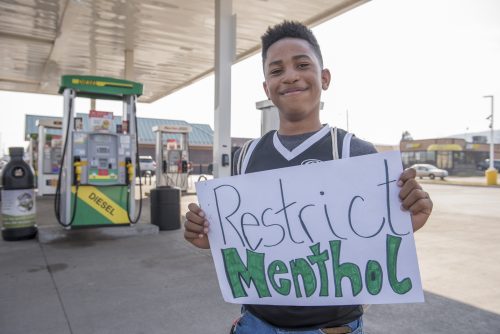
A coalition of community organizations led by the American Lung Association fought together to reduce access to menthol and other flavored tobacco in Duluth.

Roderick, a Lincoln Park Children and Families Collaborative participant, expressed his support for the Lethal Lure campaign.
The policy, which takes effect this June, takes menthol and other flavored tobacco products, including e-cigarettes, out of 84 retail locations across the city. Limiting the sale of these products to adult-only tobacco stores ensures that kids won’t be influenced by point-of-sale marketing, says Pat McKone, regional senior director for the American Lung Association (ALA).
“Tobacco is still the number-one killer of Americans. It accounts for a thousand deaths a day,” McKone said. “As the tobacco industry has had to change because of litigation, they have focused on initiation among young smokers, and targeting the point of sale.”
“Kids have an intrinsic awareness that this stuff is unhealthy, but teens who try flavored tobacco are three times more likely to go on to smoke. These are the vehicles that the industry has used to make learning to smoke more palatable,” McKone said.
And in Duluth’s case, it was community organizations who helped expand the education around the issue and build support among community members. The Lincoln Park Children and Families Collaborative (LPCFC), an organization that promotes social connectedness and healthy spaces for kids in the Lincoln Park neighborhood, was one of many community partners in the ALA-led campaign to pass the ordinance, called Lethal Lure.

Lethal Lure campaign materials distributed by the Lincoln Park Children and Families Collaborative.
“We worked with grassroots community leaders and priority populations,” said Jodi Broadwell, executive director of the LPCFC. “We’d go to organizations like the local chapter of the NAACP and community events like Duluth-Superior Pride and do prevention and education outreach.”
“The industry is targeting people who are economically and politically disenfranchised,” Broadwell said.
“We’re the most diverse neighborhood and one of the most impoverished,” Broadwell said. “We do a lot of education on youth prevention and education, so we catch our residents and children early enough that they know how they’re profiled and targeted by the commercial tobacco industry.”
The ALA and LPCFC were two of many organizations that successfully drove community interest and passion in passing the ordinance. Community residents mailed letters, wrote op-eds and attended meetings — an outcome Broadwell calls “building leadership.”
“You can get a little bit done by yourself — but you can get big things done together when you work in collaboration with other organizations,” said Broadwell.
The work of ALA and LPCFC in the Lethal Lure Campaign was funded by the Center for Prevention at Blue Cross and Blue Shield of Minnesota, which works to tackle one of the root causes of preventable disease and death — commercial tobacco use — through advocacy and community engagement.

The Lincoln Park Children and Families Collaborative serves many Anishinabe and Ojibwe families, and educating the community about the differences between sacred and commercial tobacco is an important component of its programming. Here, executive director Jodi Broadwell teaches participants Gemma and Bella about traditional tobacco.

The Lincoln Park Children and Families Collaborative engaged community members, including children and families they serve, to sign postcards, write letters to the editor, attend community meetings and events — all in support of the Lethal Lure campaign.
